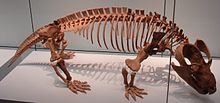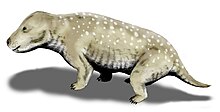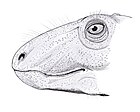Cynodontia
| Cynodonts Temporal range:
| |
|---|---|

| |
| Fossil of Belesodon magnificus in the Staatliches Museum für Naturkunde Stuttgart | |
| Scientific classification | |
| Domain: | Eukaryota |
| Kingdom: | Animalia |
| Phylum: | Chordata |
| Clade: | Synapsida |
| Clade: | Therapsida |
| Clade: | Eutheriodontia |
| Clade: | Cynodontia Owen, 1861 |
| Families | |
|
See text | |
The cynodonts ("dog teeth"), in the clade Cynodontia, are therapsids that first appeared in the Early Paleocene (approximately 260 Ma). The group includes modern mammals as well as their extinct ancestors and close relatives. Nonmammalian cynodonts spread throughout southern Gondwana and are represented by fossils from South America, Africa, India, and Antarctica. In the northern continents, fossils have been found in eastern North America as well as in Belgium and northwestern France. Cynodontia is one of the most diverse groups of therapsids.
Taxonomy
Richard Owen named Cynodontia in 1861, which he assigned to Anomodontia as a family.[1] Robert Broom (1913) reranked Cynodonia as an infraorder, since retained by others including Colbert and Kitching (1977), Carroll (1988), Gauthier et al. (1989), and Rubidge and Cristian Sidor (2001).[2] Olson (1966) assigned Cynodontia to Theriodonta, Colbert and Kitching (1977) to Theriodontia, and Rubridge and Sidor (2001) to Eutheriodontia. William King Gregory (1910), Broom (1913), Carroll (1988), Gauthier et al. (1989), Hopson and Kitching (2001) and Botha et al. (2007) all considered Cynodontia as belonging to Therapsida. Botha et al. (2007) seems to have followed Owen (1861), but without specifying taxonomic rank.[3][4]
Evolutionary history
This section needs additional citations for verification. (January 2010) |

Together with the extinct gorgonopsians and the therocephalians, the cynodonts themselves are part of a group of therapsids called theriodonts.
The oldest and the most basal cynodont yet found is Charassognathus. Other basal cynodonts were the procynosuchids, a family that includes Procynosuchus and Dvinia. Cynodonts were among the few groups of synapsids that survived the Permian–Triassic extinction event and had a slow recovery after the extinction.
The most derived cynodonts are found within the clade Eucynodontia, which also contains the members of Mammalia. Representative genera of nonmammalian cynodonts include the large carnivorous cynognathids, equally large herbivorous traversodonts, and small and mammal-like tritylodontids and ictidosaurs. The presence of respiratory turbinates suggests a rapid metabolism and possibly endothermy.
During their evolution, the jaw of the cynodonts reduced the number of jaw bones. This move towards a single bone for the mandible paved the way for other bones in the jaw, the articular and angular, to migrate to the cranium where they function as parts of the mammalian hearing system.
Cynodonts also developed a secondary palate in the roof of the mouth. This caused air flow from the nostrils to travel to a position in the back of the mouth instead of directly through it, allowing cynodonts to chew and breathe at the same time. This characteristic is present in all mammals.
Characteristics

Early cynodonts have many of the characteristics of mammals. The teeth were fully differentiated, the braincase bulged at the back of the head, and many of them walked in an upright manner. Outside of some crown-group mammals (notably the therians) all cynodonts probably laid eggs. The temporal fenestrae were much larger than those of their ancestors, and the widening of the zygomatic arch in a more mammal-like skull would have allowed for more robust jaw musculature. They also have the secondary palate that other primitive therapsids lacked, except the therocephalians, who were the closest relatives of cynodonts. The dentary was the largest bone in their lower jaw. They were probably warm-blooded.
Phylogeny





Below is a cladogram from Liu and Olsen (2010) showing one hypothesis of cynodont relationships:[5]
See also
References
- ^ Classification of R. Owen 1861.
- ^ Classification of B. S. Rubidge and C. A. Sidor 2001
- ^ R. Broom. 1913. A revision of the reptiles of the Karroo. Annals of the South African Museum 7(6):361-366
- ^ S. H. Haughton and A. S. Brink. 1954. A bibliographical list of Reptilia from the Karroo Beds of South Africa. Palaeontologia Africana 2:1-187
- ^ Attention: This template ({{cite doi}}) is deprecated. To cite the publication identified by doi:10.1007/s10914-010-9136-8, please use {{cite journal}} (if it was published in a bona fide academic journal, otherwise {{cite report}} with
|doi=10.1007/s10914-010-9136-8instead.
- Hopson, J.A.; Kitching, J.W. (2001). "A probainognathian cynodont from South Africa and the phylogeny of non-mammalian cynodonts". Bull. Mus. Comp. Zool. 156: 5–35.
- Davis, Dwight (1961). "Origin of the Mammalian Feeding Mechanism". Am. Zoologist, 1:229-234.






